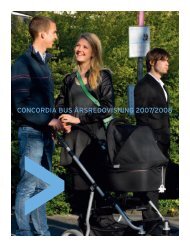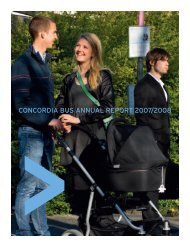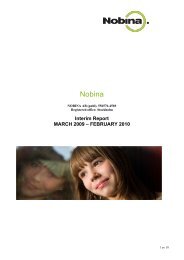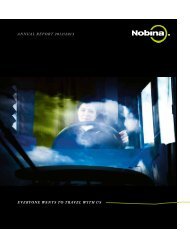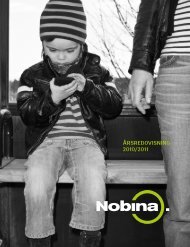Annual Report 2010/2011 - pdf 7.05 MB - Nobina AB
Annual Report 2010/2011 - pdf 7.05 MB - Nobina AB
Annual Report 2010/2011 - pdf 7.05 MB - Nobina AB
Create successful ePaper yourself
Turn your PDF publications into a flip-book with our unique Google optimized e-Paper software.
NOBINA – the OperAtIONs<br />
» By optimizing its bus fleet, <strong>Nobina</strong><br />
can operate traffic profitably.<br />
market’s needs. The offering of traffic, destinations<br />
and ticket prices is controlled by<br />
demand, and the offering is continuously<br />
developed through new payment solutions,<br />
for example, event transports, airport transfer<br />
traffic and different forms of service.<br />
With its flexibility and new schools of<br />
thought, Swebus is always quick to offer<br />
alternative transports in conjunction with<br />
disruptions in traffic.<br />
COMPrEHENSIVE trAFFIC PLANNINg SkILLS<br />
A profitable traffic contract is based on<br />
meticulous planning and resource-effective<br />
implementation. The work involved in preparing<br />
a tender is started as early as 1–2 years<br />
before the procurement procedure is initiated<br />
by the principal. During the early<br />
stages, <strong>Nobina</strong> conducts in-depth dialogues<br />
with the principal, industrial organization,<br />
employees and customers in order to analyze<br />
existing conditions for traffic patterns and<br />
potential market needs. The tender planning<br />
personnel study infrastructure, test drive the<br />
routes and review present and possible depot<br />
alternatives. The goal is to offer an attractive,<br />
profitable and realistic traffic solution for both<br />
the short and long-term.<br />
Contracts extend over several years and<br />
continuous development work is conducted<br />
in close cooperation with the principals and<br />
employee representatives to optimize schedules,<br />
traffic routes and customer offerings,<br />
with due consideration for profitability and<br />
drive-ability. The traffic planners and traffic<br />
managers are responsible for the formulation<br />
of solutions that enable traffic to move effectively<br />
and minimize empty traffic routes, for<br />
example to and from depots and waiting<br />
times and distances between transport service.<br />
All employees are encouraged to contrib-<br />
24 NOBINA | ANNuAl repOrt <strong>2010</strong>/<strong>2011</strong><br />
ute to the development work, and there are<br />
established channels for suggestions, opinions<br />
and procedures for these referrals.<br />
OPtIMAL BUS MANAgEMENt<br />
<strong>Nobina</strong> is the only traffic company in the<br />
Nordic market with its own centralized<br />
management of buses. Through efforts to<br />
optimize the bus fleet from a Group perspective,<br />
<strong>Nobina</strong> is able to improve its potential<br />
to win tenders and conduct profitable traffic<br />
operations. The goal is to continuously<br />
reduce expenses for buses, which account for<br />
about 10% of the Group’s total expenses.<br />
In <strong>2010</strong>, the bus fleet consisted of 3,618<br />
buses, comprising 648 buses owned by<br />
<strong>Nobina</strong>, 1,494 buses leased through operational<br />
contracts and 1,476 buses leased<br />
through financial contracts. More than 99%<br />
of the buses operate in traffic within the<br />
framework of contract traffic or through<br />
leasing to Swebus. When a bus is no longer<br />
needed in a contract, it can be transferred to<br />
another contract, sold or scrapped. External<br />
rentals are used in exceptional cases, usually<br />
pending a redistribution of the buses. During<br />
fiscal year <strong>2010</strong>/<strong>2011</strong>, <strong>Nobina</strong> bought<br />
395 buses and sold 330, which is slightly<br />
higher than the normal reinvestment level<br />
of about 260 buses.<br />
Selections of new buses are extremely<br />
important in optimizing the fleet of vehicles<br />
and improving resource efficiency. Standardized<br />
buses provide broader areas of application<br />
within the Group. The traffic contracts<br />
specify everything from size, disposition and<br />
appearance to environmental standards and<br />
average age, and vary from one traffic region<br />
to another. This limits opportunities to completely<br />
standardize the entire bus fleet. In<br />
parallel with deregulation of the Nordic<br />
market, opportunities are increasing to adapt<br />
the bus fleet based on market needs, longterm<br />
function and cost-optimization, rather<br />
than short-term formal demands from each<br />
individual principal.<br />
The Group’s buses have a replacement<br />
value of approximately SEK 4.6 billion and<br />
a depreciation period up to 14 years. The<br />
average age of the bus fleet today is 6.2 years,<br />
compared with the target age of seven years.<br />
<strong>Nobina</strong>’s success in optimizing the bus<br />
fleet depends on demands imposed on the<br />
buses by principals, <strong>Nobina</strong>’s foresight in<br />
traffic planning in tenders and current contracts<br />
and how well the buses are serviced<br />
and maintained in everyday operations. Last<br />
but not least, the financial solution is critical<br />
for bus management in terms of structure,<br />
control and follow-up.<br />
<strong>Nobina</strong> prioritizes financial leasing<br />
agreements that optimize the cash flow<br />
from bus financing in parallel with contract<br />
payments in the most beneficial manner.<br />
New regulations and reporting of operational<br />
leasing agreements are expected to<br />
be introduced during the summer of <strong>2011</strong>,<br />
which means that operationally leased fixed<br />
assets must be reported as assets in the<br />
consolidated balance sheet.



